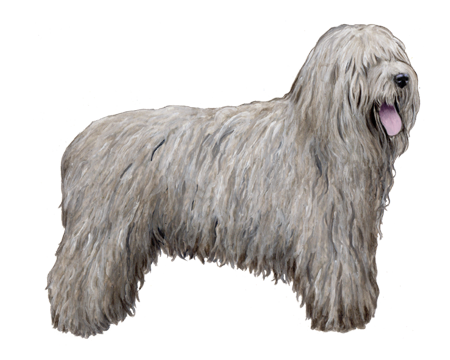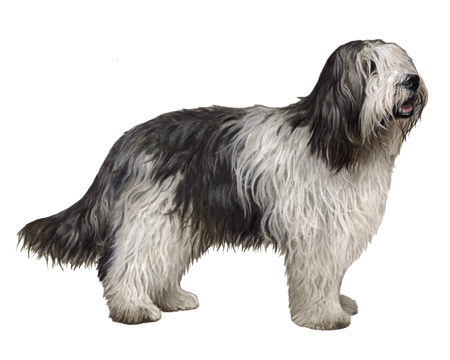
Australian Cattle Dog
The Australian Cattle Dog is a muscular herding dog with stamina to spare. These are intelligent, alert, watchful dogs with boundless energy. In the absence of a job, Australian Cattle Dogs require a home with very active owners.
Interested in discovering if your dog is an Australian Cattle Dog?
Check out Wisdom Panel's DNA tests.

Australian Cattle Dog Traits
General Appearance
Australian Cattle Dogs are strong, compact, working dogs with powerful, muscular builds that impart strength, stamina, agility, and endurance.
Coat and Colouring
Australian Cattle Dogs are double-coated with short, dense undercoats and rain-resistant outercoats with straight, hard hairs that lie flat. The coat is longer under their bodies and behind their legs, forming a mild breeching at the thighs. Their coats are also longer and thicker around their necks.
The breed comes in two colors: blue and red speckle. Australian Cattle Dogs with blue coloring should be blue, blue mottled, or blue speckled with or without other markings. The breed standard allows evenly distributed black, blue, or tan markings on the head; tan on the forelegs, breast, throat, jaws, inside of the hindlegs, inside of the thigh from the front of the stifles to the outside of the hindlegs from hocks to toes.
Australian Cattle Dogs with red speckled coloring should have an even red speckle all over their bodies, including the undercoat, with or without dark red markings on their heads.
Distinctive Physical Traits
Australian Cattle Dogs have level toplines with deep, muscular chests; strong ribs; broad, strong loins; and muscular hindquarters. The breed also has oval-shaped, medium-sized eyes; moderately-sized, pricked ears; and tails with a sloping croup that hangs in a slight curve at rest.
Australian Cattle Dog Temperament
Australian Cattle Dogs are known for their loyalty and protective instincts. These dogs are always looking out for their people and property. While they are devoted, affectionate, and playful with other pets and children, Australian Cattle Dogs are always alert and can be territorial—especially toward strangers and unfamiliar animals.


Australian Cattle Dog History
Australian Cattle Dogs hail from—you guessed it—Australia. Crossing a native Dingo with an imported Scottish smooth-coated Collie led to the creation of the breed around 1840. The dogs, also known as Blue Heelers or Queensland Heelers, were well suited to working in high temperatures and rough terrain, and helped herd cattle across rugged landscapes and long distances in the Outback. Farmers clamored for the vigilant, hardworking dogs that fast became the quintessential herding breed across Australia.
Over time, breeders crossed the earliest Australian Cattle Dogs with breeds like the Dalmatian and Black and Tan Kelpie to add traits such as ease with horses, faithfulness, and protective instincts. Their willingness to work (and skill in their roles) have earned Australian Cattle Dogs reputations as top herding dogs. The breed became charter members of the American Kennel Club’s herding group in 1983.
Australian Cattle Dog Care
Nutrition
Feed Australian Cattle Dogs a high-quality dog food that is appropriate for their life stage (e.g., puppy, adult, senior) and consider a diet formulated for active breeds. Australian Cattle Dogs that are used as working dogs may need extra nutrients to meet their needs. Talk to a veterinarian about the best options.
Though these highly active dogs are not known for being overweight, it is still a good idea to portion out their food with a measuring cup and limit treats to no more than 10% of their daily calories to avoid overfeeding.
Grooming
Australian Cattle Dogs have naturally weatherproof coats with no odors or oily residues so a quick brushing and occasional bath are all it takes to keep them looking good. During semi-annual shedding seasons, daily brushing will help remove cast-off undercoat and minimize shedding (and vacuuming). Keep their nails trimmed, too.
Like all breeds, Australian Cattle Dogs benefit from regular dental care. Start a routine that includes at-home teeth-brushing and professional cleanings to ensure good oral hygiene throughout their lives.
Exercise
This is a breed that wants to go, go, go. If given a job to do, Australian Cattle Dogs will happily work from sunrise to sunset. As pets, the breed needs a lot of exercise to be a happy and healthy companion. Long walks (or runs), trips to the dog park, swimming, hiking, or other activities that let Australian Cattle Dogs show off their stamina and endurance are ideal. It is an intelligent breed that excels in herding, agility, rally, competitive obedience, and other dog sports.
Without jobs to do, Australian Cattle Dogs will quickly get bored. High-energy playtime, puzzle toys, and learning new tricks can help Australian Cattle Dogs satisfy their need for near-constant physical and mental stimulation.
Training
Australian Cattle Dogs treat training like a job. They are intelligent and can quickly master commands and learn new tricks. Keeping training activities short and fun—but not repetitive—can help hold their attention and prevent these dogs from becoming bored and destructive. A commitment to consistent training that emphasizes positive reinforcement and rewards is best for this breed.

Australian Cattle Dog Genetic Health Conditions
-
Cystinuria Type II-A
Dogs with Cystinuria are not able to reabsorb the amino acid cystine in their kidneys and therefore high concentrations can accumulate in the urinary tract resulting in formation of cystine crystals and stones that can cause obstruction.
-
Junctional Epidermolysis Bullosa (Discovered in the Australian Cattle Dog Mix)
Junctional Epidermolysis Bullosa (JEB) is a severe skin disorder that causes skin fragility and blistering, as well as potentially significant irritations in the oral cavity. The associated genetic variant has been identified in Australian Cattle Dog mixes.
-
MDR1 Medication Sensitivity
The MDR1 gene variant causes a defect to a drug pumping protein that plays an important role in limiting drug absorption and distribution (particularly to the brain). Dogs with the MDR1 variant may have severe adverse reactions to some commonly used medications.
-
Myotonia Congenita (Discovered in Australian Cattle Dog)
Myotonia Congenita is a muscle disorder affecting dogs from birth. The condition causes affected dogs to have muscles that contract and cramp easily.
-
Neuronal Ceroid Lipofuscinosis 12 (Discovered in the Australian Cattle Dog)
Neuronal Ceroid Lipofuscinosis 12 (NCL12) is a late onset progressive disease causing uncoordinated movements and behavioral changes.
-
Primary Lens Luxation
Primary Lens Luxation (PLL) is a condition that can cause the lens of the eye to become loose and eventually displace. The disorder is caused by degeneration of the fibers that hold the lens in place.
Knowing if your Australian Cattle Dog is a carrier or at-risk for these conditions can help you and your veterinarian plan for your pup's lifelong care. With Wisdom Panel™ Premium, you can get results for over 200 genetic health tests.
Breed Group
Herding
The herding group is a diverse category. These highly intelligent breeds were developed to guard and control the movement of livestock.
Resources
https://www.akc.org/dog-breeds/australian-cattle-dog/
http://images.akc.org/pdf/breeds/standards/AustralianCattleDog.pdf
Reviewed 26 July 2020 by Laura Inman, DVM

































































